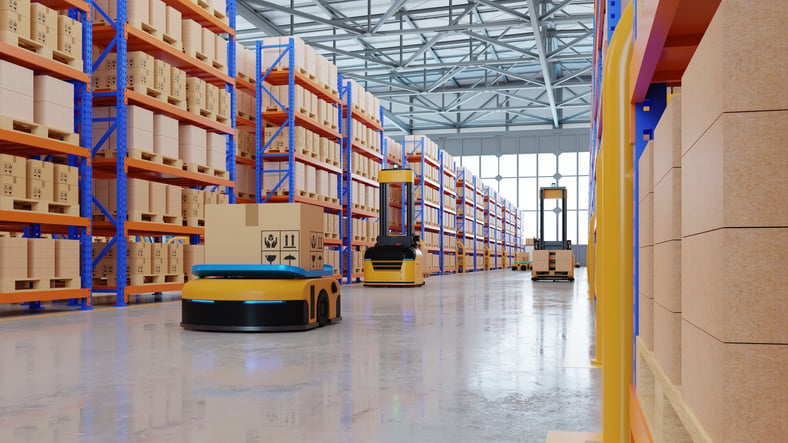Retail Logistics Trends and Challenges: A Roadmap for 3PLs

The retail logistics landscape in 2023 has been a mix of hits and misses. Technology has become more accessible — or harder to ignore — while human resource strategies have undergone significant shifts, thanks to talent shortages.
The supply chain crisis overturned decades of lean-first operations advice, as third-party logistics providers (3PLs) floundered in unpredictable consumer demand, shortages, supply delays and staffing upsets.
So, 3PLs are navigating through these challenges while trying to make the most of emerging opportunities. The trends, challenges and strategies that have shaped 2023 can provide insights for 2024.
Reviewing 2023
In just a few years, the 3PL sector has been turned on its head. After decades of lean-first operations, in which 3PLs ruthlessly minimized costs and streamlined operations, the industry is now pivoting towards a more balanced approach. This shift mirrors a broader transformation within the logistics sector, emphasizing the importance of agility, sustainability and employee well-being over strict cost reduction.
Perhaps that’s why, after decades of stalling, warehouses are finally beginning to invest in robotics, despite the steep start-up costs. Multiple reports indicate an increase in robotics in logistics. One statistic, citied in a Modern Materials Handling article, particularly caught my attention: In 2023, only 4 percent of logistics management leaders said they had no plans to use robotics in the coming years, down from 40 percent last year.
The takeaway is plain: Warehouses have had the luxury of ignoring robotics — until now. In 2023 and beyond, robotics will be necessary to survive a turbulent logistics landscape. Robotics may have significant upfront costs, but the cost of not adapting is far greater. The integration of robotics is becoming crucial to enhancing efficiency, accuracy and speed in logistics operations, enabling 3PLs to meet increasing market demands and stay competitive.
There also is a need to focus on human talent. The industry has struggled with recruiting and retaining qualified workers, with the labor shortage being a top challenge for supply chain executives. The demand for skilled labor has surged, but many logistics providers have been reluctant to meet the salary demands of these workers. To stay competitive, 3PLs need to reexamine this reluctance.
Opportunities in 2024
In 2024, I predict savvy 3PLs will take advantage of new opportunities to become more robust against 2023’s market volatility as well as gain more streamlined operations.
The main opportunity? The integration of artificial intelligence (AI), either on its own or in conjunction with robotics. While robotics adoption took more than half a century, AI’s integration with 3PLs will be much smoother due to the lower startup costs. AI software can be integrated into existing systems to optimize routes, manage inventories and forecast demands, without the need for substantial upfront investment in new hardware or infrastructure, in stark contrast to robotic conveyor belts or automated pickers.
It’s likely that 3PLs will gain benefits from AI alone. AI can optimize warehouse space utilization and predict maintenance needs, preventing unexpected downtime and extending equipment life spans. However, the combination of AI and robotics is even more powerful.
Imagine: AI is the brain, meticulously analyzing data and orchestrating movements. AI scrutinizes warehouse layout and inventory locations, determining the most optimal and safe routes for robots to traverse, ensuring efficiency and safety are in harmony. AI forecasts demand, predicting which items will be needed, allowing for proactive inventory management. And It also optimizes the allocation of tasks based on real-time conditions, ensuring that 3PLs utilize their resources most efficiently.
Meanwhile, robots are the brawn, executing the decisions AI makes. They navigate predetermined routes, pick up items from their optimized locations, and transport them to their destinations, all the while adjusting their actions based on real-time feedback from AI.
Together, AI and robotics can automate and optimize warehousing operations, reducing labor costs and human errors, and enhancing customer satisfaction through faster and more accurate order fulfillment.
It’s also important that 3PLs look more closely at the human element. Talent retention and recruitment are easier than they’re made out to be. Employees consistently report prioritizing two things: pay and flexibility. If you can offer those, you’ll have far fewer staffing issues than warehouses that don’t.
Eventually, it will prove more expensive for 3PLs to be consistently short-staffed, scrambling to hire new employees, versus paying existing employees more and giving them more flexible scheduling options.
Success in 2024
To be a successful 3PL in 2024, best practices include embracing new and enhanced technologies. Many 3PLs have been slow to adopt robotics because they could afford to be. Everything was fine — until it wasn’t. Then, there was a supply chain crisis compounded by a labor shortage, along with floods of customers ordering online goods. These 3PLs went under. Today, you should accept robotics into the warehouse and proactively seek additional types of technology to optimize your workflow.
Also, reevaluate wages and schedule policies to retain talent. Many 3PLs may feel that with robotics and AI on the horizon, humans will no longer be necessary. This isn’t true. Humans will always be needed for decision-making, problem-solving and overseeing technology. The human element brings a level of adaptability and creativity that technology alone cannot replicate.
Therefore, 3PLs should be focusing on creating a conducive working environment, offering competitive salaries and providing flexible schedules. Employee satisfaction directly correlates with productivity and efficiency, and a happy workforce is more likely to stay put, reducing turnover and recruitment costs.
And don’t stop there. Keep abreast of industry trends and adopt informed decision-making strategies to adapt to consumer demands and market dynamics. Prepare for tomorrow’s challenges today to ensure a smoother transition, regardless of the unpredictability that 2024 may bring.


